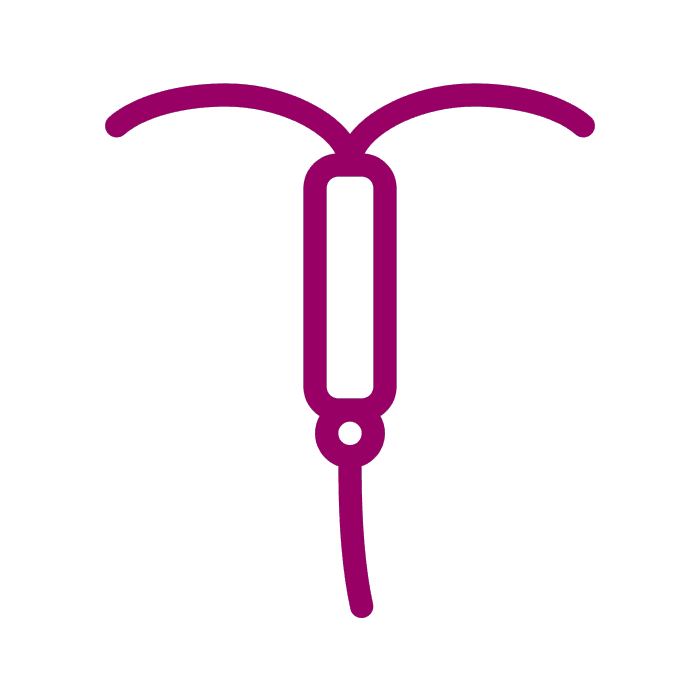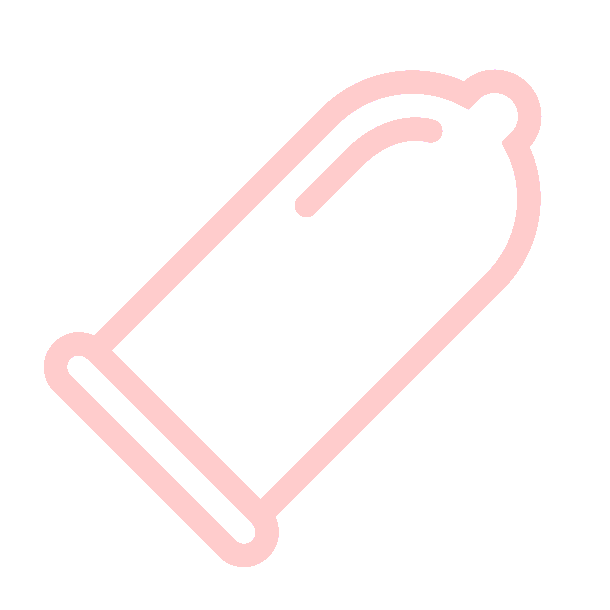
CONTRACEPTIVE RING
Hormonal Method
A flexible plastic ring constantly releasing hormones that is placed in the vagina by the woman.
91 % Effective
Details
The contraceptive ring, also called the vaginal ring, is a small, soft plastic ring that is placed in the vagina and releases a steady dose of hormones into your bloodstream over a month. These hormones, oestrogen and progesterone, prevent pregnancy by stopping the release of an egg from your ovary (ovulation), thickening the mucus in your cervix to stop the sperm from entering your uterus, as well as thinning the lining of your uterus so it is less likely that a fertilised egg will attach.
It provides contraception for 1 month, after which you replace it. You can have sex and use tampons while the ring is in your vagina. If used correctly, it is 97% effective in preventing pregnancy.
Talk to your healthcare professional about the best time to start using the ring and whether you need to use additional contraception. They can also give you advice on how to insert and remove it.
How to
The ring sits against the vaginal wall and is inserted almost like a tampon. You press the opposite sides of the ring together and gently push the folded ring entirely inside the vagina. Inserting it deeply helps to keep it in place and makes it less likely that you will feel it. The ring is left in place for 3 weeks, after which you remove it, have a week’s break, and then insert a new one. During this break, you might have a period-type bleed.
If the ring falls out, or you forget to replace it, read the Patient Information Leaflet that comes in the box with your rings to find out what you should do. If you are in doubt or have any questions, speak to your healthcare provider.
Pros
It is an effective form of contraception
It does not interrupt sex
It is easy to put in and take out
You don’t have to remember to take it every day – you only have to remember to change it every 3 weeks
It may make your periods more regular, lighter and less painful
Cons
You need to keep track to remember to change it every 3 weeks
You may not feel comfortable inserting or removing the ring
You may have spotting and bleeding in the first few months
Some women may experience temporary side effects
It does not protect you against sexually transmitted infections (STIs), such as HIV), so you may need to use condoms as well
You and your partner may feel the ring during sex. This is not harmful.
Side Effects
You may experience:
Changes in your monthly bleeding patterns:
Lighter bleeding and fewer days of bleeding
Irregular bleeding
Infrequent bleeding
Periods that last longer
No monthly bleeding
These changes in bleeding are normal and are not harmful. If you find them bothersome, speak to your healthcare professional.
Headaches
Irritation, redness, or inflammation of the vagina (vaginitis)
White vaginal discharge
Frequently Asked Questions
-
The vaginal ring is a small soft, plastic ring that you place inside your vagina.
It releases a continuous dose of oestrogen and progestogen hormones into the bloodstream to prevent pregnancy.
-
Consult your doctor or healthcare provider to ensure you are not pregnant before starting with the vaginal ring. Talk to your doctor or healthcare provider for more details and read the patient information leaflet for basic directions on how to start using the vaginal ring.
-
The ring can slip or accidentally come out of your vagina during sexual intercourse, bowel movements, or when removing a tampon. If the ring falls out, it should be rinsed off and replaced as soon as possible. You should still be protected against pregnancy if it has been out for less than three hours. If it has been out for more than 3 hours, a backup method of contraception, such as condoms, is needed for the next seven days. The ring must remain inside for at least seven more days after being out for longer than 3 hours; this may mean that you wear it for more than 21 days that month. Following this, you may have a one-week ring-free interval before inserting the next ring.
-
Insert the ring as soon as you remember and use a backup contraceptive method for seven days. If you have unprotected sex after the contraceptive ring has been out for more than one week, consider using emergency contraception. You should not go more than seven days without wearing a contraceptive ring, as you will be at risk of getting pregnant. Talk to your doctor or healthcare provider if you are unsure.
-
The ring may break, which can cause the contraceptive ring to lose shape. If the ring stays in your vagina, this should not lower the effectiveness of preventing pregnancy. If the vaginal ring breaks and slips out of your vagina, throw the broken ring in the trash and insert a new vaginal ring.
-
You will still get pregnancy protection if you leave the contraceptive ring in your vagina for up to 4 weeks (28 days). Remove your old vaginal ring for one week (7 days) and insert a new one week (7 days) later.
Remove the contraceptive ring after four weeks (28 days) has elapsed. Check that you are not pregnant with a pregnancy test kit. Insert a new contraceptive ring and use a backup method of contraception such as a condom for the next seven days. You may have irregular bleeding or no period that month.
Use another contraceptive method, such as condoms, until after the new vaginal ring has been inside for seven days.















CONTRACEPTIVE METHODS
CONTRACEPTIVE METHODS
-

CONTRACEPTIVE IMPLANT
1 or 2 small hormone-releasing silicone rods placed under the skin by a healthcare provider.
-

CONTRACEPTIVE INJECTION
The contraceptive injection is a shot of hormones that lasts for 1 up to 3 months.
-

CONTRACEPTIVE PATCH
A patch that sticks to the skin and releases hormones that are highly effective at stopping pregnancy.
-

DIAPHRAGM
A diaphragm is a small dome that blocks the entrance to the cervix to stop sperm from entering the womb.
-

EMERGENCY CONTRACEPTIVES
Emergency contraceptives are hormone-based pills that are used in the event of accidental unprotected sex.
-

FEMALE CONDOM
A female condom is a sheath that is placed inside a woman’s vagina before sexual intercourse.
-

FERTILITY AWARENESS
Fertility awareness is the method of only having sex on the non-fertile days of your menstrual cycle.
-

INTRAUTERINE DEVICE
An IUD is a small, flexible, often T-shaped device wrapped in copper that is placed inside your womb by your healthcare provider.
-

INTRAUTERINE SYSTEM-IUS
An IUS is a small, flexible, T-shaped system that releases low levels of hormones and is placed inside the womb by your healthcare provider.
-

MALE CONDOM
A condom is a thin film sheath that is placed over a man’s erect penis before having sex.
-

PULL-OUT METHOD
Pulling out (also called Withdrawal Method) requires no additional hormones or devices, just impeccable timing and a lot of luck.
-

SPERMICIDES
Spermicides affect the way sperm travels in the womb making it hard for them to move freely and fertilize an egg.
-

SPONGE
A sponge blocks the entrance to the cervix and releases spermicide, both together stopping sperm from entering the womb and fertilizing an egg.
-

STERILISATION
Sterilisation is the process of completely taking away the body’s ability to reproduce through surgery or minimal invasion.
-

THE PILL
The pill is a small tablet containing hormones that must be swallowed every day, at the same time.



